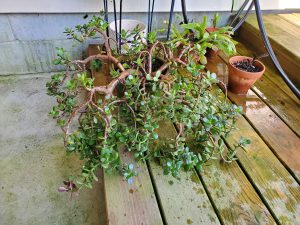It seems like every time I pick up a home and garden type magazine, the cover photo is dotted with flowering orchids and indoor foliage plants that are inevitably in pristine condition. However, years of experience troubleshooting issues with both my own interior plants and those for clients tell a different story. All too often, indoor potted plants languish for years, barely alive, until they finally succumb. I’ve taken several to the plant graveyard just past the edge of the back yard because of this exact scenario. In recent times though, I’ve figured out a way to mostly avoid pitiful looking indoor plants – take them outside in the warm months!
To appreciate the perks of getting your indoor plants outdoors, it’s helpful to first think about why most interior situations aren’t very conducive to plant growth. There are three primary reasons houseplants fail: not enough light, improper watering, and low humidity. Most plant species grown for interiorscapes hail from the tropics where they grow in the understory of large trees, receive bright, filtered sunlight, and experience abundant moisture and humidity. These conditions are VERY hard to mimic in the typical American house unless you huddle all your plants near windows, take steps to increase humidity (which doesn’t play super well with furniture and other household items), and really tune in your watering. Taking indoor plants outside to play in the Panhandle summers just really makes the whole situation much easier!

A Jade Plant that had languished indoors during the winter beginning to perk up outside! Photo courtesy of Daniel Leonard.
Now that you’ve made the decision to move your indoor plants out, figuring out where to site them is the next step. I’ve found that, with few exceptions, houseplants prefer to be in a bright area but away from direct sunlight – under mature trees, on a covered porch, anywhere that doesn’t get direct sunlight will do! It is also a great idea to place plants near a watering source. If a hose doesn’t easily reach the spot or it’s inconvenient to tote a watering can to them, your plants won’t get watered regularly and will suffer. You’ll be surprised how much water plants use when they’re in conditions conducive to growth so be sure to check pots every couple of days to prevent droughty conditions! Once in these new and improved growing conditions, your houseplants will also respond very well to a little extra fertilizer. A good general prescription is a topdressing of a slow-release fertilizer using the recommended label rate as soon as you bring them outside and following that up once each month with a supplemental liquid fertilizer.
Keeping houseplants happy in the Florida summer is easy and begins with getting them outside. Find a spot with bright, indirect light, keep them watered well, add a little fertilizer, and watch them grow like they never have before! For more information on growing houseplants or any other horticultural or agricultural topic, contact your local UF/IFAS County Extension office. Happy gardening!
- Supertunia Vista® Bubblegum® – The Toughest Petunia Around - July 11, 2025
- Doveweed Control in Centipedegrass Lawns & Landscaped Beds - June 5, 2025
- Another Plea to End Crape Murder - April 21, 2025
